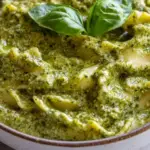Mastering Pesto Cream Sauce: A Beginner’s Guide to a Rich and Flavorful Pasta Dish
This Pesto Cream Sauce is the perfect balance of rich, velvety texture and fresh, herby goodness. Whether tossed with pasta, drizzled over chicken, or used as a dip, this beginner-friendly recipe will elevate your meals with minimal effort! 🍝🧄🧀
- Prep Time: 5 minutes
- Cook Time: 10 minutes
- Total Time: 10 minutes
- Yield: 4 servings 1x
Ingredients
- ¾ cup heavy cream – Creates the rich and smooth texture of the sauce.
- ⅓ cup water – Helps to thin the sauce slightly while keeping it creamy.
- 2 tablespoons unsalted butter – Adds a silky finish and enhances the flavor.
- ½ cup pesto sauce – The star ingredient, providing a fresh and herbaceous taste.
- ½ cup shredded parmesan cheese – Melts into the sauce for a salty, nutty depth.
- Salt and pepper to taste – Adjust depending on the saltiness of your pesto.
Protein Option (Alternative to Pork-Based Additions)
- 1 cup cooked, shredded or diced chicken – A great way to add protein without overpowering the sauce.
- 1 cup thinly sliced grilled steak or beef strips – For a richer, heartier version of this dish.
Instructions
Step 1: Simmer the Cream and Water
In a large skillet over medium heat, pour in the heavy cream and water. Stir gently and bring the mixture to a very gentle simmer. Be careful not to let it boil, as dairy can curdle at high temperatures. This process should take 2-3 minutes.
Step 2: Add Butter and Pesto
Once the cream mixture is warmed, add the unsalted butter. Stir continuously until it melts completely into the sauce. Next, mix in the pesto sauce, ensuring it is evenly distributed. Allow the sauce to simmer for 5 minutes on low heat, stirring occasionally to prevent burning.
Step 3: Incorporate Parmesan Cheese
Gradually sprinkle in the parmesan cheese, stirring continuously so it melts smoothly into the sauce. This will help thicken the mixture and enhance its flavor. Let it cook for another 2 minutes, ensuring everything is well combined.
Step 4: Add Protein (Optional)
If using chicken or beef, stir it into the sauce at this stage. Make sure the protein is pre-cooked so it warms up without needing additional cooking time.
Step 5: Toss with Pasta and Serve
Add your cooked pasta directly into the skillet and toss everything together, making sure the sauce coats the noodles evenly. Serve immediately while warm.
Notes
Preventing a Curdled Sauce
Dairy-based sauces can sometimes separate or curdle if cooked at too high a temperature. Keep your heat at medium-low and avoid boiling the cream. Stir frequently to maintain a smooth consistency.
How to Tell If Your Sauce Is Ready
The sauce should be thick but pourable. If it looks too thick, add a splash of pasta water or milk to thin it out. If it is too thin, let it simmer for an extra minute while stirring.
Enhancing the Flavor
- If your pesto is store-bought, consider adding a squeeze of lemon juice or a pinch of red pepper flakes for extra brightness and heat.
- Freshly grated parmesan melts better than pre-shredded varieties and creates a smoother sauce.
- Using homemade pesto will give you a fresher, more vibrant taste.
Cooking Pasta Like a Pro
- Salt your pasta water generously before boiling. This enhances the overall taste of the dish.
- Cook pasta until al dente, meaning it should still have a slight bite to it. Overcooked pasta becomes mushy when mixed with a creamy sauce.
- Reserve ½ cup of pasta water before draining. This starchy water can help adjust the sauce’s consistency.
